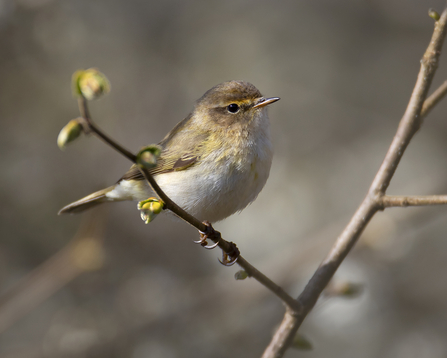As the vibrant hues of spring begin to emerge, March offers a delightful spectacle of awakening nature. Keep an eye out for these captivating species this month!

© Jon Hawkins Surrey Hills Photography
The Chiffchaff is a migrant warbler, and one of the first to arrive to the UK in spring, becoming suddenly plentiful in South England by the end of March. It will sing its name, ‘chiffchaff, chiffchaff’, from a position high up in a tree, even when it is in the middle of searching for food. The Chiffchaff usually nests close to the ground amid dense shrubbery, in a clumsy ball of dead leaves or moss, and grass; however, it will sometimes nest higher in evergreen trees. Later in spring, the female will lay around six eggs that are white with dark red spots.

© Ross Hoddinott/2020VISION
A lover of damp conditions, Wild Garlic often appears in swathes on sloping woodland banks or by woodland streams. Emitting a strong oniony smell, the plant is a relative of the cultivated Garlic we use for cooking, as well as of onions, leeks and shallots. Wild Garlic has broad, pointed leaves set on long stalks. These gave the plant its name, as ‘gar’ was the Anglo-Saxon term for spear, and ‘lic’ comes from the word ‘leek’ – so the plant was the ‘spear-leek’. Today, it is commonly known as Ramson.
© Chloé Valerie Harmsworth
The Brimstone butterfly is often the first butterfly you will see in spring. The male is bright yellow (the female a paler greenish-yellow), and so it stands out while flitting along the still-brown woodland edges and hedgerows. The male’s original name of ‘butter-coloured fly’ is likely to be the origin of the name now used for this whole group of insects. In Tove Jansson’s magical novel, Finn Family Moomintroll, it is said that if the first butterfly you see in spring is a yellow one, you will have a happy summer.
Wood Anenome at Hobbyhorse Wood © Emma Matthars
The Wood Anemone is an indicator of ancient woodland – woods that have been in existence since 1600 or earlier. Just before the bluebells arrive, the woodland floor will be scattered in March and April with these sweet, six- to seven-petalled white flowers with prominent yellow stamens. ‘Anemone’ is a Greek word for ‘wind-flower’, as they thought the flower only opened when the wind blew. When evening comes, or the sky is overcast, the flowers close up to protect themselves from the cold and rain. The Wood Anemone’s leaves are divided into three toothed leaflets.
Why not head to one of our nature reserves and witness the wonders of spring up close? You can find more information about our reserves as well as practical visiting information here. And don't forget to share your findings and snapshots with us — we'd love to see what you encounter! Tag us on social media at @hertswildlifetrust on Instagram and Facebook, and @HMWTBadger on X/Twitter, or email us at media@hmwt.org
If you're passionate about safeguarding the future of these species and other local wildlife, please consider making a donation to support our conservation work. Thank you!
Thanks to Chloé Valerie Harmsworth our Business Manager at Herts Environmental Records Centre, Herts & Middlesex Wildlife Trust, the species text is taken from her book ‘The Secret Life of a Woodland Habitat: Life Through the Seasons’

